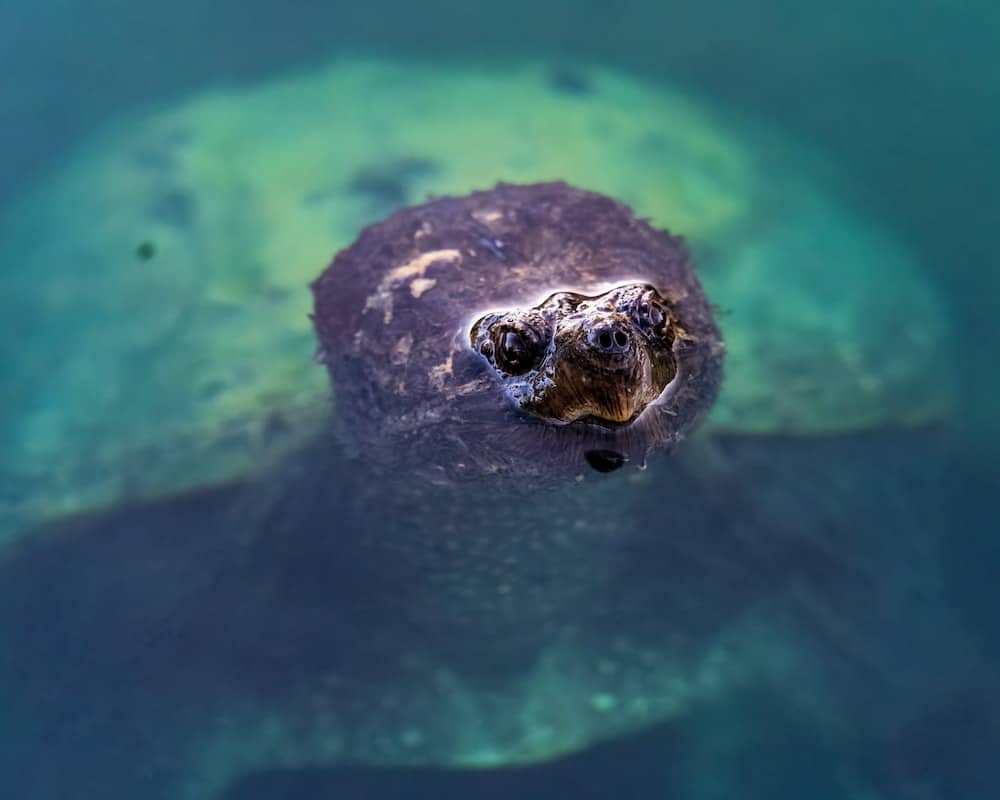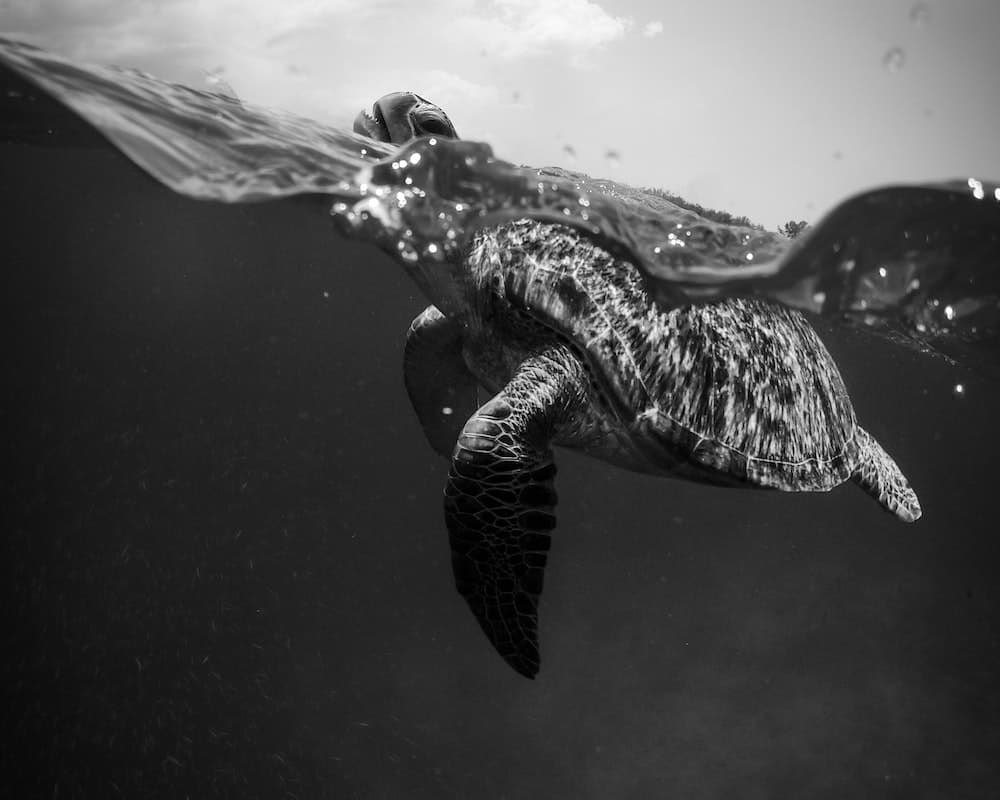Yes, snapping turtles can breathe very easily underwater. Their body evolves, changes, and adapts to breathing while it is sunk deep inside the water. They do that by using a process called cloacal respiration. In this process, they breathe through the opening, which is usually used to pump out the waste from their body.
Top 4 Reasons Why Snapping Turtles Can Breathe Underwater
From their adaptations to how their metabolism functions, there are various reasons why snapping turtles can breathe underwater.
- Physiological Adaptations
Your snapping turtle has evolved and adapted many physiological traits, including breathing underwater. They use a process known as cloacal respiration to extract oxygen from water.
You must be wondering what cloaca is. So, the cloaca is a multifunctional opening in your pet’s tail. Your pet mainly uses the Cloaca opening to throw out waste materials. It also acts as the place where the reproductive activity takes place. People popularly call this process the “breathing from the butt” process.
The cloaca in your pet has these unique structures: thin-walled sacs that are heavily supplied with blood vessels called bursae. They are also responsible for respiration in these reptiles.
The bursae sacs are placed in your pet’s cloaca lining and automatically get filled with water when these reptiles are underwater. The water filled in these sacs has dissolved oxygen, which gets released into their bloodstream when the turtle is under the water.
This process also has many drawbacks and depends on many other factors. The amount of oxygen that your pet can extract from water depends on the oxygen level of the water, the temperature of the water, and many other internal processes of your pet.
- Buoyancy Control
Your pet can physically show another adaptation or evolution in their internal system; it can control its buoyancy. They can hold and adjust the air in their lungs, which helps them maintain their position in the water.
When these turtles think and want to go underwater, they can release air stored in their lungs, making them negatively buoyant and helping them reach the bed of the water or go to the ground in water. This allows those turtles who want to go into hibernation or want to save energy and oxygen while they are underwater.
In contrast, when your pet wants to come out on the surface water and feels like moving up, it can do so by filling the air in its lungs again. This way, your pet’s lungs will expand, become positively buoyant, and eventually rise to the water’s surface.
This ability of your pet is beneficial when they want to hunt in the water. As they sink deep into the water, they sit there without moving, and most of the animals pass by without noticing these turtles, thus giving these turtles a great chance to hunt them and feed upon them.
This ability of these reptiles to control the oxygen level in their lungs also helps them to escape any danger they could face underwater.
- Oxygen Tolerance
These reptiles have this unique capability of “breathing without oxygen.” Your pet does not always need oxygen to stay alive. They can use the glucose stored in their body to convert and pass on the energy to the body, which your pet will use to do little movements whenever needed underwater. This particular type of breathing is known as anaerobic respiration.
Though they don’t feel safe using this breathing technique if your pet is stuck somewhere in a frozen lake, it might live upon this type of breathing and stay alive for as long as 100 days.
- Metabolic Rate
A snapping turtle’s survival underwater depends a lot on its metabolic rate. Suppose the snapping turtle burns more energy inside the water instead of hibernating. In that case, your pet has become more active and it would need more oxygen to breathe inside.
However, eventually, they will only be able to stay for a few minutes inside the water because the alternative breathing system these snapping turtles contain cannot support them for longer if they are active.
For example, if your pet is hunting too much inside the water or running after their prey for long distances, it must return to the surface within 6-10 minutes to breathe correctly with its lungs.
How Long Can A Snapping Turtle Stay Underwater?
Your snapping turtle is known amongst all the animals for its ability to adapt to being able to breathe underwater and swim as perfectly as a fish does. They can stay for a long time under the water in a stretch.
On average, you can notice that your snapping turtles can stay underwater for about 45 minutes to maybe an hour. Some are also seen submerged in water for more than an hour. Ultimately, any snapping turtle’s time spent underwater is decided by its capacity to control its metabolic rates and oxygen flow in the lungs.
When it’s extremely cold outside or near the surface, they may spend around five months i.e., one whole season underwater. But for this, they must prepare their body accordingly and use various alternate breathing methods.
How Long Can A Snapping Turtle Hold Its Breath?
As we discussed above, your pet is blessed with the ability to do anaerobic respiration. Due to this ability, they can move without breathing oxygen for as long as 100 days.
A turtle’s metabolic rate plays a vital role in its ability to breathe through anaerobic respiration. This metabolic rate is, in turn, dependent on the temperature outside the surface and the activeness of your pet inside the water.
If the temperature is too high or warm outside, these reptiles need more energy. Thus their metabolic rate will be high, and they will have to breathe continuously. It can hold its breath for about 30-50 minutes in this situation.
Conclusion
Wrapping up the article, it is clear that there are various ways by which these snapping turtles can breathe underwater. Cloacal respiration, buoyancy control, and oxygen control are some of the main ways they can breathe and be supported underwater. Anaerobic respiration is one of the best adaptive techniques your snapping turtle may use to stay underwater for an extended period.
Your pet is known to be one of the most intelligent reptiles when it comes to hunting, and when they are underwater, they are indeed very cunning in catching their prey. They sit inside the water deep down without any motion, thus making their best possible move and using all their energy to hunt their prey.
These reptiles are very strong swimmers, unlike box turtles, they can swim when necessary. They may enter shallow water and paddle, but they are not aquatic turtles and do not spend extended periods in the water.
FAQs
- Can Baby Snapping Turtles Breathe Underwater?
Yes, a baby snapping turtle can also breathe easily underwater like an adult. They can also use the cloaca respiratory system to breathe through the uterus’s opening or their butt.
- Can A Snapping Turtle Drown?
If, in any case, a snapping turtle is stuck anywhere and it becomes too late to reach the surface when required, it may suffocate to death. These are sporadic cases until some hunter has spread out a net, or some predator might want to feed upon them.




